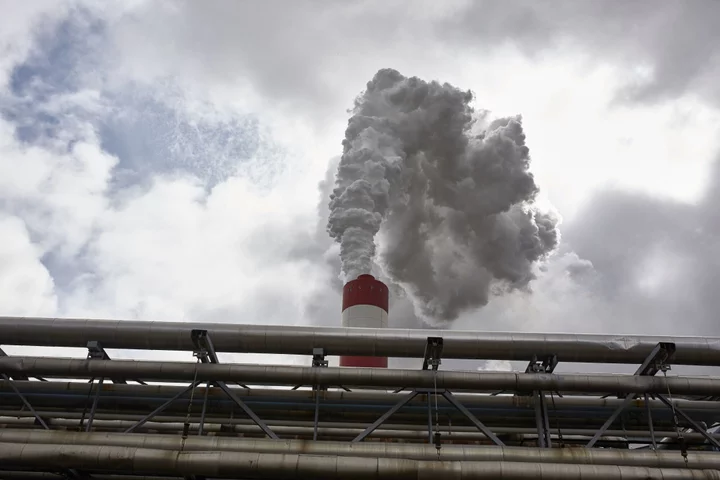The US is getting its first commercial facility to soak up carbon dioxide from the ambient air for permanent storage, a nascent technology that’s been both lauded as crucial in fighting climate change and derided as a distraction that will delay the clean energy transition.
The plant near San Francisco, built by Bay Area startup Heirloom Carbon Technologies, puts California at the forefront of the emerging carbon removal industry as a handful of so-called direct air capture (DAC) hubs are also slated to get underway. Heirloom’s facility, unveiled Thursday, will be capable of removing and storing as much as 1,000 tons of carbon dioxide each year.
That’s a pittance compared with bigger plants poised to come online in Texas and Louisiana, but it’s enough to serve as a milestone for a technology that’s likely to spawn a significant business. JPMorgan Chase & Co. and Google parent Alphabet Inc. are among the companies that have pledged hundreds of millions to buy carbon removal services, even as critics warn the industry will give oil producers an excuse to keep pumping crude.
Heirloom raised $53 million in a 2022 Series A round from investors including Microsoft's Climate Innovation Fund and Bill Gates' Breakthrough Energy Ventures. While Heirloom declined to disclose the price tag to build the California facility, the company aims to operate at a cost of $100 per ton of carbon removed by 2030 — a price point the young industry currently isn’t close to reaching.
Read More: How Carbon Capture Is Getting New Life With US Help
The Biden administration is throwing its weight behind the technology, too. In August, the Department of Energy announced the first wave of projects that won some of the $3.5 billion in funding for developing DAC hubs around the US. Though the Tracy facility is not a recipient of those dollars, Heirloom is part of one of those projects and its technology will be deployed at a major hub in Louisiana the government expects will remove 1 million tons of CO2 a year by the end of the decade. Heirloom and other DAC companies can also receive tax credits from the Inflation Reduction Act.
Research shows that gathering billions of tons of the greenhouse gas from the air each year by mid-century — in addition to rapid emissions reductions — will almost certainly be needed to limit global warming to 1.5C. Carbon capture and removal is “positioned to play an important role in decarbonizing the US economy,” according to BloombergNEF. The carbon market could reach $1 trillion by 2037 if rules prioritize high-quality removals, BNEF found in a separate analysis.
DAC, which is still in its infancy, uses vacuum-like machines to pull CO2 out of the atmosphere and store it using a variety of methods. Heirloom’s facility will use an electric-powered kiln to heat crushed limestone, transforming it into a calcium-based paste that’s spread onto stacked trays that act as carbon-absorbing sponges. Once saturated with the CO2, the material returns to the kiln, where the carbon is removed before the process repeats. The Tracy plant will store CO2 in tanks, though Heirloom and other companies plan to inject it deep underground for future projects.
The facility’s technology differs from a more controversial method called carbon capture, which involves removing CO2 emitted at the smokestack. That technology can help decarbonize heavy industry, but oil companies have deployed it to capture CO2 then inject it underground to help extract more fossil fuels. The practice, known as enhanced oil recovery, has long been scrutinized by environmentalists who fear it could prolong the lifespan of fossil fuels. Occidental Petroleum Corp. — which is leading a DAC hub in Texas — has said sucking CO2 from the air is crucial to its strategy to keep producing oil.
Read More: An Oil Giant Quietly Ditched the World’s Biggest Carbon Capture Plant
Though Heirloom’s has said it won’t use its technology to perpetuate the fossil fuel industry, many environmentalists and local communities remain opposed to the technology as a whole due to safety concerns over ruptured pipelines and mass asphyxiation from leaks. They also worry state and federal leaders are taking a gamble on a technology that is largely untested and too expensive to operate. For reference, the largest DAC facility in the world, created by Swiss startup Climeworks, removes 4,000 tons of CO2 a year, an amount less than 270 average Americans’ annual carbon footprints.
“We’re very concerned,” said Katie Valenzuela, a policy advocate at the California Environmental Justice Alliance. “Direct air capture still carries all of the same concerns we have with carbon capture and without those safety measures in place, it’s going to have potentially really negative impacts on frontline communities.”
Read More: Carbon Removal Isn't Just for Corporations. Individuals Are Paying For It, Too
Heirloom has sold a share of its carbon removal credits to various companies, including Microsoft, Stripe and Shopify. But Valenzuela is concerned that the company could participate in the Low Carbon Fuel Standard, a market system that allows carbon-intensive transportation companies to purchase credits instead of taking steps to use cleaner fuels, she said.
“It’s problematic because these credits will be used instead of reducing carbon at fossil fuel operations,” she added.
But research shows removing carbon from the atmosphere is necessary to realistically meet the US’s 2050 carbon-neutral target. California is also relying on capture and removal methods to eliminate about 100 million tons of CO2 annually to reach carbon neutrality by 2045. That could include other techniques to pull CO2 from the air, including adding crushed rocks to soil and zapping seawater. Beyond cleaning up carbon, policymakers tout that the budding industry will create thousands of high-income jobs for workers affected by the energy transition.
“Projects like this Heirloom facility are exactly the sort of big and innovative ideas that we’re embracing – using renewable energy to directly remove pollution from our air, all while creating good-paying jobs in the Central Valley,” Governor Gavin Newsom said in a statement.

